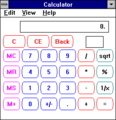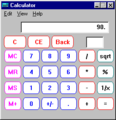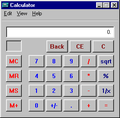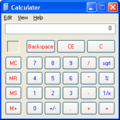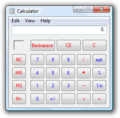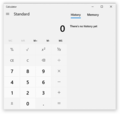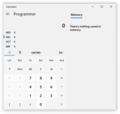Calculator
| Component of Microsoft Windows | |
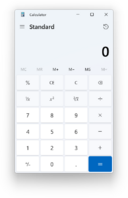 Calculator in Windows 11 | |
| File name/executable | calc.exe |
|---|---|
| Type | Math processor |
| Included in | Windows 1.0 and later |
Calculator is an application for mathematical operations that was first introduced with Windows 1.0.
History[edit | edit source]
Calculator was already included in the very first builds of Windows 1.0. In Windows 3.0, the program was completely re-written, adding a Scientific mode allowing for more complex operations such as sin or log. The Calculator was overhauled yet again for Windows 95, using the new 3D common controls, though the design and functionality remained mostly the same. In Windows XP, Calculator was updated to use themed/styled controls, but through Windows Vista, the fundamentals of Calculator were unchanged save for some reorganizations of buttons. In Windows 7, the Calculator app got redesigned and the program received features like History, Programmer Mode, Statistics Mode, Date Calculation and Unit Conversion. In Windows 8.1, a Metro-based version was introduced, evolving into a version based on UWP in Windows 10. Consequently, the original Calculator was removed, save for its LTSC variant. In Windows 10 build 16226, a currency converter was introduced. The UWP version of Calculator was made open-source in 2019 and its source code was made available on GitHub.[1] In Windows 11 build 22000.132, a WinUI 2.7 version was introduced. This would be backported to recent versions of Windows 10 via Microsoft Store in late 2022.
Gallery[edit | edit source]
Calculator in Windows 1.0 DR5
Calculator in Windows 1.01
Calculator in Windows/386 2.11
Calculator set to scientific mode in Windows 3.0 with Multimedia Extensions 1.0
Calculator in Windows NT 3.51
Calculator in Windows 95 build 90c
Calculator in Windows 95
Calculator in Windows XP
Calculator in Windows Vista
Calculator in Windows 7
Calculator in Windows 8
Metro calculator in Windows 8.1
Calculator in the original release of Windows 10
Currency converter in Windows 10 build 16226
Windows 10 2022 Update[edit | edit source]
Windows 11[edit | edit source]
References[edit | edit source]
- ↑ Warren, Tom. Microsoft open-sources its Windows calculator on GitHub, The Verge. 6 March 2019.




